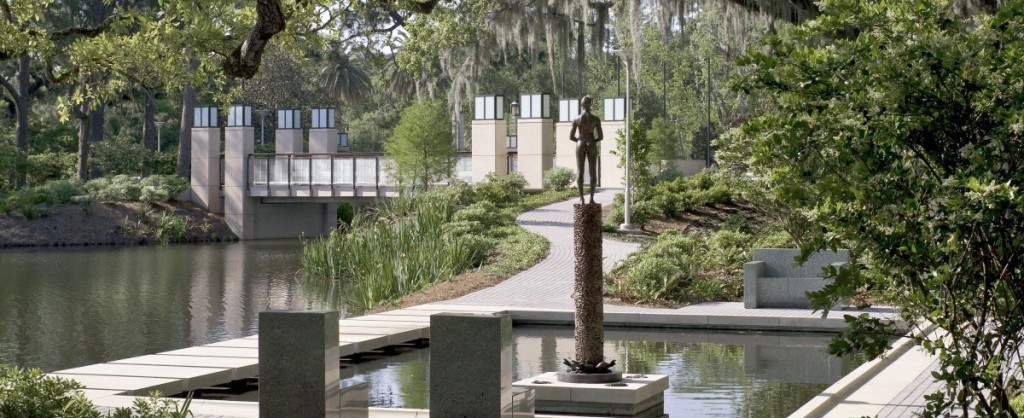To hear Sharon Litwin’s interview with Lake Douglas on WWNO radio, click here.
Hard to believe that Daylight Saving Time begins on Sunday. Already it’s spring, although the trees and flowers have known that for weeks.
With the season come thoughts of planting and gardens, both private and public. But not everyone has the artistic vision to design an elegant outdoor space nor a green thumb, even in this area of lush foliage. So for someone like me, who practices her own horticultural version of Darwin’s Theory of Evolution (if it lives, it lives; if it dies, it dies), it’s probably best to go sit some other place and be the beneficiary of a real landscape architect’s skills.
We are lucky in our city to have a number of sites to choose from. So imagine my surprise to learn that, in New Orleans, the identification of landscape architecture as a formal academic occupation is fairly new. The history of our 200-year-old city’s outdoor design landscape made me think such skills must be the outcome of a profession long taught.
Not so, says Lake Douglas, Associate Professor in the Robert Reich School of Landscape Architecture at Louisiana State University.
Numerous examples of early professionally designed outdoor spaces exist around town; the New Orleans Botanical Garden, one of the few remaining examples of public garden design from the 1930s Art Deco period, is one. It was built by William Weidorn, a professionally trained landscape architect from Cornell University brought down to work on City Park. But it wasn’t until several years later that another Cornell University graduate and ardent believer arrived in Louisiana, bent on creating a formally accredited university academic program.
“ ‘Doc’ Reich, as we call him now, came to Louisiana in the ‘40s and started the program,” Lake says of Robert Reich, for whom the LSU School of Landscape Architecture is named and who died in 2010. “He remained on faculty teaching until he died. Students actually went to see him in assisted living, where he worked with them up to age 97.”

The Sculpture Garden at City Park reflects the way that landscape architecture -- and architects -- have shaped the local environment.
Today landscape architecture projects can range from those as modest as private garden designs to those addressing issues of such huge scale as coastal erosion or managing environmental disasters.
Currently involved in a grass-roots effort to increase this city’s inventory of public green spaces through the creation of the Lafitte Corridor Greenway, Lake uses several already-constructed projects to demonstrate to his students excellent examples of thoughtful and successful local landscape architecture.
“You can look at improvements to the Audubon Zoo, which used to be thought of as an animal ghetto and now is one of the most impressive zoos in the world,” he says. “And then there’s the new Big Lake area of City Park, a project made possible through the Trust for Public Land. When you pass by it you can see people walking, running, skateboarding from 7 in the morning until 7 at night. It’s wonderful.”
So, now that the days will be longer and it’s not yet 90 degrees with 98 percent humidity, go check out some of these wonderful examples. And if that’s too strenuous a task to contemplate, you can always pick up Lake Douglas’s book on the subject, “Public Gardens, Private Spaces,” published by LSU Press, and just sit in the sun and read about them.
Sharon Litwin is president of NolaVie.
 NOLAbeings Multimedia artist Claire Bangser created NOLAbeings as a portrait-based story project that marries...
NOLAbeings Multimedia artist Claire Bangser created NOLAbeings as a portrait-based story project that marries...  Voodoo in New Orleans: Reviving history: New Orleans fortune telling This article takes a deep dive into the history of Voodoo in New Orleans, its hybridization with Catholicism, and its present-day place in the city's culture. The author visits fortune-tellers in the French Quarter, using their guidance as a tool for introspection rather than a deterministic predictor of the future. Through her experiences in New Orleans, the author feels a mystical connection to both the past and the future.
Voodoo in New Orleans: Reviving history: New Orleans fortune telling This article takes a deep dive into the history of Voodoo in New Orleans, its hybridization with Catholicism, and its present-day place in the city's culture. The author visits fortune-tellers in the French Quarter, using their guidance as a tool for introspection rather than a deterministic predictor of the future. Through her experiences in New Orleans, the author feels a mystical connection to both the past and the future. 